SAT SUBJECT TEST MATH LEVEL 1
MODEL TESTS
![]()
CHAPTER 22
Model Test 3
![]()
50 Questions / 60 MINUTES
Directions: For each question, determine which of the answer choices is correct and fill in the oval on the answer sheet that corresponds to your choice.
Notes:
1. You will need to use a scientific or graphing calculator to answer some of the questions.
2. Be sure your calculator is in degree mode.
3. Each figure on this test is drawn as accurately as possible unless it is specifically indicated that the figure has not been drawn to scale.
4. The domain of any function f is the set of all real numbers x for which f (x) is also a real number, unless the question indicates that the domain has been restricted in some way.
5. The box below contains five formulas that you may need to answer one or more of the questions.
Reference Information. This box contains formulas for the volumes of three solids and the areas of two of them.
For a sphere with radius r :
• ![]()
• A = 4πr2
For a right circular cone with radius r, circumference c, height h, and slant height l:
• ![]()
• ![]()
For a pyramid with base area B and height h:
• ![]()
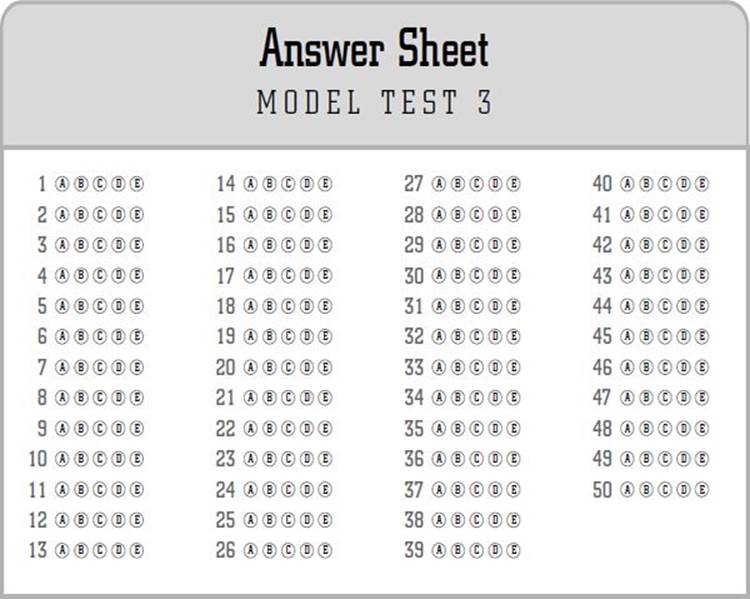
1. If ![]() then x =
then x =
(A) –10
(B) –2
(C) 0
(D) 2
(E) 10
2. If x = –3 and y = 2, what is the value of 2x2 – 3y 2?
(A) –30
(B) –6
(C) 0
(D) 6
(E) 18
3. What is the value of 3|–5| + 5|–3|?
(A) –30
(B) –15
(C) 0
(D) 15
(E) 30
4. If f (x) = x 4 – x 2 and g(x) = x 3 – 3x 2 + 2x, then for all values of x for which g(x) ![]() 0,
0, 
(A) ![]()
(B) ![]()
(C) ![]()
(D) ![]()
(E) ![]()
5. If x ![]() 0, then
0, then ![]() =
=
(A) ![]()
(B) 4
(C) ![]()
(D) ![]()
(E) ![]()
6. If Lior flips five fair coins and if, for each of them, Ezra guesses whether it landed heads or tails, what is the probability that Ezra makes at least one correct guess?
(A) .16
(B) .50
(C) .80
(D) .97
(E) 2.5
7. If y = 3x and 2x + 3y = 22, then y =
(A) 2
(B) 3
(C) 6
(D) ![]()
(E) ![]()
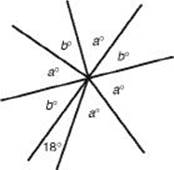
Note: Figure not drawn to scale.
8. If in the figure above, the ratio of a to b is 3 to 2, then what is the value of a + b ?
(A) 38
(B) 57
(C) 76
(D) 95
(E) 113
9. Which of the following statements about the solution set of ![]() is true?
is true?
(A) The solution set is the empty set.
(B) The solution set has exactly one member.
(C) The solution set has exactly two positive members.
(D) The solution set has exactly two negative members.
(E) The solution set has one positive member and one negative member.
10. What is the reciprocal of the sum of the reciprocals of 2 and 3?
(A) ![]()
(B) ![]()
(C) ![]()
(D) ![]()
(E) ![]()
11. If ![]() , then n =
, then n =
(A) ![]()
(B) ![]()
(C) 2
(D) 3
(E) 4
12. If in quadrilateral ABCD,
m![]() A:m
A:m![]() B:m
B:m![]() C:m
C:m![]() D = 1:1:2:2, which of the following statements could be true?
D = 1:1:2:2, which of the following statements could be true?
I. ABCD is a parallelogram.
II. ABCD is a rhombus.
III. ABCD is a trapezoid.
(A) I only
(B) III only
(C) I and II only
(D) I and III only
(E) I, II, and III
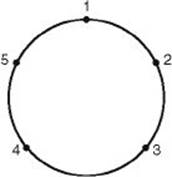
13. In how many ways can Hillary, Ira, Jack, Ken, and Lou sit around the table above if either Ira or Jack must sit in seat 1 and neither Ken nor Lou can sit in seat 5?
(A) 6
(B) 12
(C) 24
(D) 48
(E) 120
14. Which of the following is the equation of a line that is perpendicular to the line whose equation is y = 2x and that has a negative x-intercept?
(A) y = 2x – 1
(B) y = –2x + 1
(C) ![]()
(D) ![]()
(E) ![]()
15. For what value(s) of n is ![]() = n – 1?
= n – 1?
(A) 0
(B) 3
(C) 0 and 3
(D) 1 and – 1
(E) No values
16. If f (x) = x 2 – 5 and g (x) = x 2 + 5, what is the value of f (g (5))?
(A) 0
(B) 50
(C) 405
(D) 600
(E) 895
17. If the average of 5 positive integers is 70, what is the largest possible value of their median?
(A) 70
(B) 114
(C) 116
(D) 201
(E) 346
18. If ![]() is parallel to the line whose equation is x + y = 11, then
is parallel to the line whose equation is x + y = 11, then ![]() must pass through which quadrants?
must pass through which quadrants?
(A) I and II
(B) I and IV
(C) II and IV
(D) I, II, and IV
(E) II, III and IV
19. If angles P and Q are supplementary, angles Q and R are complementary, and x is the sum of the measure of the three angles, then which of the following must be true?
(A) x = 90°
(B) 90° < x < 180°
(C) x = 180°
(D) 180° < x < 270°
(E) x = 270°
20. If |x + 3| < 2, which of the following must be true?
I. x is negative
II. x + 3 < 2
III. –x – 3 < –2
(A) I only
(B) II only
(C) I and II only
(D) II and III only
(E) I, II, and III
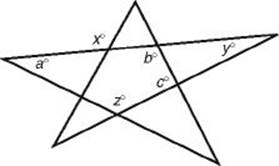
Note: Figure not drawn to scale.
21. In the figure above, if x = 110, y = 40, and z = 130, what is the value of a + b + c ?
(A) 170
(B) 230
(C) 290
(D) 320
(E) 410
22. If A is the point (5, 4) and B is the point (–3, –2), what is the area of the circle that has ![]() as a diameter?
as a diameter?
(A) 8![]()
(B) 10![]()
(C) 20![]()
(D) 25![]()
(E) 100![]()
23. What is the value of log9 27?
(A) ![]()
(B) 1
(C) ![]()
(D) 2
(E) 3
24. The perimeter of a square is a inches, and the area of the square is b square inches. If a + b = 45, what is the length in inches of one of the sides?
(A) 4.5
(B) 5
(C) 9
(D) ![]()
(E) ![]()
25. In ![]() ABC, C is a right angle and tan A = 1. What is the value of sin A + cos A?
ABC, C is a right angle and tan A = 1. What is the value of sin A + cos A?
(A) ![]()
(B) 1
(C) ![]()
(D) 2
(E) ![]()
26. If ![]()
(A) (x + 3)3 – 5
(B) (x + 5)3 + 3
(C) (x – 3)3 + 5
(D) (x + 5)3 – 3
(E) f –1(x) does not exist
27. There are 25 students in Mrs. Wang’s first-period algebra class. On Monday, five students were absent and the other 20 students took a test. The average grade for those students was 86. The next day after the five absent students took the test, the class average was 88. What was the average of those five students’ grades?
(A) 90
(B) 92
(C) 94
(D) 96
(E) 98
28. What is the sum of the x= and y= coordinates of the point where the lines y = 3x + 2 and y = 2x + 3 intersect?
(A) 1
(B) 5
(C) 6
(D) 11
(E) 12
29. For what value of k will the equation 5x 2 + 6x + 3k = 0 have exactly one solution?
(A) 0
(B) ![]()
(C) ![]()
(D) 1
(E) ![]()
30. On January 1, 1990, the value of a certificate of deposit (CD) was $765. If the value of the CD increased by 6% each year, what was its value, in dollars, on January 1, 2002?
(A) 1,316
(B) 1,370
(C) 1,498
(D) 1,539
(E) 1,611
31. Which of the following lines has the greatest y-intercept?
(A) y = 3x + 10
(B) 2y = x + 15
(C) x + y = 12
(D) ![]()
(E) x – y – 25 = 0
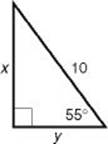
32. In the figure above, what is the value of x – y ?
(A) 0.14
(B) 1.43
(C) 2.46
(D) 6.09
(E) 8.55
33. What is the area of an equilateral triangle whose perimeter is 10?
(A) 4.81
(B) 5.56
(C) 7.86
(D) 43.30
(E) 50
34. If a cube whose edges are x has the same volume as a rectangular solid whose length, width, and height are x, x – 3, and x + 4, respectively, then x =
(A) 9
(B) 12
(C) 16
(D) 144
(E) 1,728
35. What is the greater of the two y-intercepts of the circle whose center is at (3, –2) and whose radius is 4?
(A) –4.65
(B) 0.65
(C) 1.65
(D) 2.65
(E) 4.65
36. If ![]() which of the following is a number that is NOT in the domain of f ?
which of the following is a number that is NOT in the domain of f ?
(A) –4
(B) –3
(C) 3
(D) 4
(E) All real numbers are in the domain.
37. If 0° < x < 90°, then ![]()
(A) sin x + cos x
(B) sin x – cos x
(C) sin2x – cos2x
(D) sin3x – cos3x
(E) sin3x + cos3x
38. If i 2 = –1, which of the following are real numbers?
I. i 21
II. i 21 + i 22
III. i 21 + i 22 + i 23
(A) None
(B) I only
(C) II only
(D) III only
(E) I, II, and III
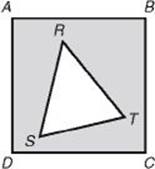
Note: Figure not drawn to scale.
39. In the figure above, ABCD is a square and RST is an equilateral triangle. If the area of the shaded region is 3 times the area of the white triangle and if RT = 2, then what is AB ?
(A) 2
(B) ![]()
(C) ![]()
(D) ![]()
(E) ![]()
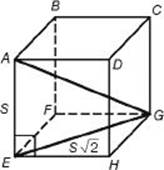
40. In cube ABCDEFGH, the length of diagonal ![]() is 9. What is the volume of the cube?
is 9. What is the volume of the cube?
(A) ![]()
(B) ![]()
(C) ![]()
(D) ![]()
(E) 729
41. If b and c are real numbers, i 2 = –1, and r + si is a root of the equation 2x2 + bx + c = 0, which of the following must be true?
I. r – si is a root of the equation
II. b = –4r
III. c = 2r 2 + 2s2
(A) None
(B) I only
(C) I and II only
(D) I and III only
(E) I, II, and III
42. What is the area of a circle that is inscribed in an equilateral triangle whose sides are 2?
(A) ![]()
(B) ![]()
(C) ![]()
(D) ![]()
(E)3 ![]()
43. If f (x) = 7x + 3 and g(x) = 2x – 5, which of the following statements must be true?
I. The lines y = f (g(x)) and y = g(f (x)) are parallel.
II. The lines y = f (g(x)) and y = g(f (x)) are perpendicular.
III. The line y = f (g(x)) – g(f (x)) is horizontal.
(A) None
(B) I only
(C) II only
(D) III only
(E) I and III only
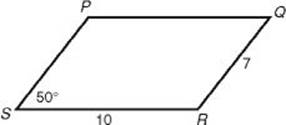
44. What is the area of parallelogram PQRS above?
(A) 45.0
(B) 53.6
(C) 61.8
(D) 70.0
(E) 83.4
45. “If London is the capital of England, then Moscow is the capital of France” is logically equivalent to which of the following statements:
(A) London is the capital of England and Moscow is not the capital of France.
(B) If London is the capital of England, then Moscow is not the capital of France.
(C) If Moscow is the capital of France, then London is the capital of England.
(D) If Moscow is not the capital of France, then London is not the capital of England.
(E) Moscow is not the capital of France, and London is the capital of England.
46. If f (x) = 4x + 7, g(x) = 7x + 4, and h(x) = (f og)(x), then which of the following is h–1(x)?
(A) 11x + 11
(B) 28x 2 + 65x + 28
(C) 4x – 7
(D) 7x – 4
(E) ![]()
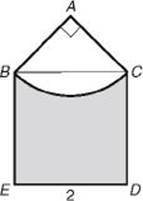
47. In the diagram above, BCDE is a square and ![]() ABC is a right isosceles triangle. Arc
ABC is a right isosceles triangle. Arc ![]() is the arc of a circle whose center is at A. If ED = 2, what is the area of the shaded region?
is the arc of a circle whose center is at A. If ED = 2, what is the area of the shaded region?
(A) ![]()
(B) ![]()
(C) 6 – 2 ![]()
(D) 2 ![]() –6
–6
(E) 5 – ![]()
48. How many pounds of peanuts must be added to a mixture of 20 pounds of peanuts and 50 pounds of cashews if the resulting mixture is to be 60% peanuts by weight?
(A) 12
(B) 30
(C) 42
(D) 52
(E) 55
49. If a sphere and a right circular cone have the same radius and equal volumes, what is the ratio of the height of the cylinder to its radius?
(A) ![]()
(B) 4
(C) ![]()
(D) ![]()
(E) ![]()
50. The first two terms of a sequence are 4 and 5, and each subsequent term is the sum of the two preceding terms. (For example, the third term is 4 + 5 = 9, and the fourth term is 5 + 9 = 14.) How many of the first 1,000 terms are odd?
(A) 333
(B) 334
(C) 500
(D) 666
(E) 667
Answer Key
MODEL TEST 3
|
1. E |
18. C |
35. B |
||
|
2. D |
19. D |
36. E |
||
|
3. E |
20. C |
37. A |
||
|
4. B |
21. B |
38. D |
||
|
5. E |
22. D |
39. D |
||
|
6. D |
23. C |
40. D |
||
|
7. C |
24. B |
41. E |
||
|
8. D |
25. C |
42. A |
||
|
9. E |
26. A |
43. E |
||
|
10. E |
27. D |
44. B |
||
|
11. D |
28. C |
45. D |
||
|
12. B |
29. B |
46. E |
||
|
13. C |
30. D |
47. B |
||
|
14. E |
31. D |
48. E |
||
|
15. B |
32. C |
49. B |
||
|
16. E |
33. A |
50. D |
||
|
17. C |
34. B |
ANSWERS EXPLAINED
For many of the questions in this model test, an alternative solution, indicated by two asterisks (**), follows the first solution. Almost always the first solution is the direct mathematical one and the other is based on one of the tactics discussed in the “Tactics” chapter.
See Important Tactics for an explanation of the symbol ⇒, which is used in several answer explanations.
1. (E) Use TACTIC C2: solve proportions by cross multiplying:

**Of course, anytime you need to solve for a single variable, you can backsolve (TACTIC 2).
2. (D) 2x2 – 3y2 = 2(–3)2 – 3(22) = 2(9) – 3(4) = 18 – 12 = 6
3. (E) 3|–5| + 5|–3| = 3(5) + 5(3) = 15 + 15 = 30
4. (B) Factor the numerator and the denominator and simplify:
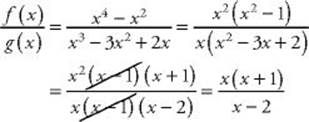
**You can avoid the algebra by using TACTIC 3: plug in a number for x. For example, if x = 3:

Only choice B equals 12 when x = 3.
5. (E) ![]()
**Use TACTIC 3: replace x with a number, say x = 2. Then  Only choices D and E are equal to 1 when x = 2. So eliminate A, B, and C and pick another number for x, say
Only choices D and E are equal to 1 when x = 2. So eliminate A, B, and C and pick another number for x, say  Of choices D and E, only choice E equals 4 when x = 4.
Of choices D and E, only choice E equals 4 when x = 4.
![]() 6. (D) For each coin, the probability that Ezra guesses wrong is
6. (D) For each coin, the probability that Ezra guesses wrong is ![]() . So the probability that he guesses wrong 5 times in a row is
. So the probability that he guesses wrong 5 times in a row is ![]() . The probability that he does not guess incorrectly each time (and hence the probability that he is correct at least once) is
. The probability that he does not guess incorrectly each time (and hence the probability that he is correct at least once) is ![]()
7. (C) y = 3x ![]() 3y = 9x
3y = 9x ![]() 2x + 3y = 2x + 9x = 11x. So 11x = 22. Therefore, x = 2 and y = 3(2) = 6.
2x + 3y = 2x + 9x = 11x. So 11x = 22. Therefore, x = 2 and y = 3(2) = 6.
**Use TACTIC 2: backsolve. Start with 6, choice C, which happens to work.
8. (D) Use KEY FACT C1 and let a = 3x and b = 2x. By KEY FACT G3, the sum of all the angles in the given figure is 360°, so:
![]() 4a + 3b + 18 = 360
4a + 3b + 18 = 360 ![]() 4(3x) + 3(2x) + 18 = 360
4(3x) + 3(2x) + 18 = 360
So, 12x + 6x = 342 ![]() 18x = 342
18x = 342 ![]() x = 19
x = 19
Therefore, a = 57, b = 38, and a + b = 57 + 38 = 95
9. (E) Use TACTIC C2: cross multiply and solve:
w(w + 3) = 3(w + 12) ![]() w2 + 3w = 3w + 36
w2 + 3w = 3w + 36
So, w2 = 36 ![]() w = 6 or w = –6
w = 6 or w = –6
The solution set has one positive member and one negative member.
10. (E) The reciprocals of 2 and 3 are ![]() and
and ![]() . Their sum is
. Their sum is ![]() The reciprocal of
The reciprocal of ![]() is
is ![]() .
.
![]() 11. (D)
11. (D) ![]()
12. (B) Since the sum of the measures of the four angles in any quadrilateral is 360° (KEY FACT I1) and since the measures of the angles are in the ratio of 1 : 1 : 2 : 2, by KEY FACT C1, for some number x, the measures of the angles are x, x, 2x, and 2x. Therefore:
x + x + 2x + 2x = 360 ![]() 6x = 360
6x = 360 ![]() x = 60.
x = 60.
So m![]() A = 60°, m
A = 60°, m![]() B = 60°, m
B = 60°, m![]() C = 120°, and m
C = 120°, and m![]() D = 120°. In a parallelogram (and hence a rhombus), by KEY FACT I4 the sum of the measures of any two adjacent angles (for example, angles A and B) is 180°, so I and II are false and you can eliminate choices A, C, D, and E. The answer must be B. In fact, ABCD has to be an isosceles trapezoid.
D = 120°. In a parallelogram (and hence a rhombus), by KEY FACT I4 the sum of the measures of any two adjacent angles (for example, angles A and B) is 180°, so I and II are false and you can eliminate choices A, C, D, and E. The answer must be B. In fact, ABCD has to be an isosceles trapezoid.
13. (C) Use KEY FACT O2 (the counting principle). There are 2 choices for seat 1: Ira or Jack. After one of them is assigned to seat 1, there are 2 choices for seat 5: Hillary and whichever of Ira or Jack has not been assigned to seat 1. Then, since there are no more restrictions, there are 3 ways to assign seat 2, 2 ways to assign seat 3, and only 1 way to assign seat 4. There are a total of 2 × 2 × 3 × 2 × 1 = 24 ways for the five people to be seated.
14. (E) By KEY FACT L8, the slope of y = 2x is 2, and by KEY FACT L7, the slope of any line perpendicular to it is – ![]() . Eliminate choices A, B, and C.
. Eliminate choices A, B, and C.
Now check choices D and E to see which has a negative x-intercept. To find the x-intercept, let y = 0.

The answer is E.
**On a graphing calculator, graph y = 2x and each choice.
15. (B) Square both sides of the equation ![]() = n – 1:
= n – 1:
n + 1 = (n – 1)2 = n2 – 2n + 1 ![]() n2 – 3n = 0
n2 – 3n = 0 ![]() n(n – 3) = 0
n(n – 3) = 0 ![]() n = 0 or n = 3
n = 0 or n = 3
Check both values:
• ![]() = 2 = 3 – 1, so 3 works
= 2 = 3 – 1, so 3 works
• ![]() = 1
= 1 ![]() 0 – 1, so 0 does not work
0 – 1, so 0 does not work
The only solution is 3.
**Use TACTIC 2: backsolve. Test 0. Since it doesn’t work, eliminate choices A and C. Test 3. Since it works, eliminate D and E.
![]() 16. (E) g(5) = 52 + 5 = 30. So, f(g(5)) = f (30) = 302 – 5 = 900 – 5 = 895
16. (E) g(5) = 52 + 5 = 30. So, f(g(5)) = f (30) = 302 – 5 = 900 – 5 = 895
17. (C) By TACTIC O1, if the average of 5 numbers is 70, their sum is 5 × 70 = 350. The median of the 5 numbers is the middle one when they are listed in increasing order. To make the third one as large as possible, make the others as small as possible. Since the numbers are not necessarily different positive integers, the two smallest could both be 1: 1, 1, ___, ___, ___. That leaves 348 for the remaining 3 integers. Since the fourth and fifth numbers must be at least as large as the third, the most the median could be is 348 ÷ 3 = 116. The five numbers could be 1, 1, 116, 116, 116.
18. (C) By rewriting x + y = 11 as y = –x + 11, you see that by KEY FACT L8, the slope of the given line is –1. Therefore, by KEY FACT L7, the slope of line ![]() is also –1. Any line whose slope is negative must pass through quadrants II and IV. The line y = –x + 2 passes through quadrant I, but not quadrant III; the line y = –x – 2 passes through quadrant III, but not quadrant I; and the line y = –x passes through neither quadrant I nor quadrant III.
is also –1. Any line whose slope is negative must pass through quadrants II and IV. The line y = –x + 2 passes through quadrant I, but not quadrant III; the line y = –x – 2 passes through quadrant III, but not quadrant I; and the line y = –x passes through neither quadrant I nor quadrant III.
19. (D) Since angles P and Q are supplementary, m![]() P + m
P + m![]() Q = 180°. Since angles Q and R are complementary, m
Q = 180°. Since angles Q and R are complementary, m![]() Q + m
Q + m![]() R = 90°
R = 90° ![]() m
m![]() R < 90°. Therefore, 180° < m
R < 90°. Therefore, 180° < m![]() P + m
P + m![]() Q + m
Q + m![]() R < 180° + 90° = 270°.
R < 180° + 90° = 270°.
20. (C) By KEY FACT A2, |x + 3| < 2 ![]() –2 < x + 3 < 2 (II is true). Also, x + 3 < 2
–2 < x + 3 < 2 (II is true). Also, x + 3 < 2 ![]() x < –1, so x must be negative (I is true). Statement III is equivalent to the inequality x + 3 > 2, which is false. Only I and II are true.
x < –1, so x must be negative (I is true). Statement III is equivalent to the inequality x + 3 > 2, which is false. Only I and II are true.
21. (B) In problems such as this, just fill in every angle you can until you have all the angles you need. For easy reference, we have labeled several of the angles.
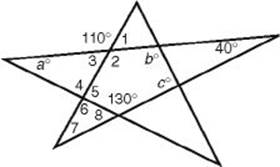
Since the sum of the measures of the two angles in a linear pair is 180° (KEY FACT G2), m![]() 1 = 70° and m
1 = 70° and m![]() 8 = 50°.
8 = 50°.
Since vertical angles are congruent (KEY FACT G4), m![]() 2 = 110° and m
2 = 110° and m![]() 3 = 70°.
3 = 70°.
Since the sum of the measures of the three angles in a triangle is 180°,
40° = m∠2 + m∠7 = 180° ⇒ 40° + 110° + m∠7 = 30°.
Similarly, m∠6 = m∠7 + m∠8 = 180° ⇒ m∠6 = 100°.
Then m∠A = 100° ⇒ a = 10°. Also m∠5 = 80°. Finally, since by KEY FACT I2 the sum of the measures of the 5 angles in a pentagon is (5 – 2)(180°) = 540°:

22. (D) By KEY FACT L3, AB, the distance from A to B, is:
![]()
So the diameter of the circle is 10, the radius is 5, and by KEY FACT J8, the area is ![]()
23. (C) By KEY FACT A15:

**By KEY FACT A16:
![]()
24. (B) Let s represent the length of a side. Then a = 4s and b = s2. So:
a + b = 45 ![]() 4s + s2 = 45
4s + s2 = 45 ![]() s2 + 4s – 45 = 0
s2 + 4s – 45 = 0 ![]()
(s + 9)(s – 5) = 0 ![]() s = –9 or s = 5
s = –9 or s = 5
Since s must be positive, s = 5.
**Use TACTIC 2: backsolve.
25. (C) Draw right triangle ABC.
Since tan A = 1, and by KEY FACT M1,
tan ![]() , then AC = BC.
, then AC = BC.

Assume AC and BC are each 1; then by KEY FACT H7, AB = ![]() . So, again by KEY FACT M1:
. So, again by KEY FACT M1:

Since ![]() is not an answer choice, you can either:
is not an answer choice, you can either:
• Rationalize the denominator:
![]()
![]() • Use your calculator:
• Use your calculator: ![]() =1.414.
=1.414.
Only choice C, ![]() , equals 1.414.
, equals 1.414.
![]() **Use your calculator to find A: A = tan–1(1) = 45°. Then:
**Use your calculator to find A: A = tan–1(1) = 45°. Then:
![]()
26. (A) Use KEY FACT N8. In the equation ![]() switch x and y and solve for y:
switch x and y and solve for y:
![]()
![]() 27. (D) The original 20 students earned a total of 20 × 86 = 1,720 points. The total number of points earned by all 25 students was 25 × 88 = 2,200. Therefore, the five students who took the test late earned a total of 2,200 – 1,720 = 480 points. So their average was 480 ÷ 5 = 96.
27. (D) The original 20 students earned a total of 20 × 86 = 1,720 points. The total number of points earned by all 25 students was 25 × 88 = 2,200. Therefore, the five students who took the test late earned a total of 2,200 – 1,720 = 480 points. So their average was 480 ÷ 5 = 96.
**Let x be the average of the five students, and treat this as a weighted average problem:
![]()
28. (C) Since y = 3x + 2 and y = 2x + 3, then 3x + 2 = 2x + 3 ![]() x = 1. So the x=coordinate of the point of intersection is 1. To find the y-coordinate, plug x = 1 into either equation, say y = 3x + 2: y = 3(1) + 2 = 5. So the point of intersection of the two lines is (1, 5), and the sum of the x- and y-coordinates is 1 + 5 = 6.
x = 1. So the x=coordinate of the point of intersection is 1. To find the y-coordinate, plug x = 1 into either equation, say y = 3x + 2: y = 3(1) + 2 = 5. So the point of intersection of the two lines is (1, 5), and the sum of the x- and y-coordinates is 1 + 5 = 6.
![]() **Graphing the two lines on a graphing calculator would easily get you the answer but probably no faster than would the algebraic solution.
**Graphing the two lines on a graphing calculator would easily get you the answer but probably no faster than would the algebraic solution.
**If you don’t have a graphing calculator and want to avoid the algebra, you could make a quick sketch, which would surely eliminate choices A, D, and E.
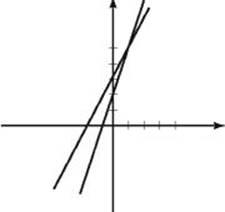
29. (B) By KEY FACT E2, a quadratic equation has exactly one solution if and only if its discriminant equals 0. In the equation 5x2 + 6x + 3k = 0, the discriminant, D, is:
b2 – 4ac, where a = 5, b = 6, and c = 3k
So, D = 62 – 4(5)(3k) = 36 – 60k, and
![]()
![]() 30. (D) On January 1, 1991, the value of the CD was 765 + 0.06(765) = (1.06)(765). On January 1 of each year, the value of the CD was (1.06) times its value on January 1 of the preceding year. After 12 years, the value of the CD was (1.06)12(765) = 1,539.
30. (D) On January 1, 1991, the value of the CD was 765 + 0.06(765) = (1.06)(765). On January 1 of each year, the value of the CD was (1.06) times its value on January 1 of the preceding year. After 12 years, the value of the CD was (1.06)12(765) = 1,539.
31. (D) Since the x-coordinate of any point on the y-axis is 0, replace x by 0 in each of the choices and determine which has the greatest y-value. In choice D, when x = 0, y = 20. In each of the other choices, the value of y is less than 20.
**Rewrite each equation in the form y = mx + b. Choice D becomes y = x + 20. So by KEY FACT L8, its y-intercept is 20. The other equations all have values of b less than 20.
32. (C) By KEY FACT M1

You do not have to evaluate x and y separately and then subtract. You can do it all on one line on your calculator.
33. (A) Use TACTIC 4: draw and label a diagram. Since the perimeter of the triangle is 10, each side is ![]() Since
Since ![]() PSQ is a 30-60-90 right triangle, by KEY FACT H8,
PSQ is a 30-60-90 right triangle, by KEY FACT H8, ![]()
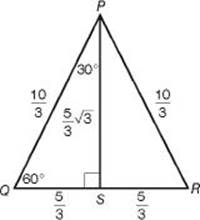
![]() By KEY FACT H11, the area of an equilateral triangle of side sis
By KEY FACT H11, the area of an equilateral triangle of side sis 
![]() **If you don’t remember the formula for the area of an equilateral triangle, use the formula
**If you don’t remember the formula for the area of an equilateral triangle, use the formula ![]() and by KEY FACT H8,
and by KEY FACT H8, ![]() . So
. So
![]()
34. (B) By KEY FACT K1, the volume of the cube is x3, and the volume of the rectangular solid is:

![]() **Use TACTIC 2: backsolve. If x = 16, the volume of the cube is 163 = 4,096 and the volume of the rectangular solid is (16)(13)(20) = 4,160. Since 4096 and 4160 are close, try a number close to 16, say 12. It works.
**Use TACTIC 2: backsolve. If x = 16, the volume of the cube is 163 = 4,096 and the volume of the rectangular solid is (16)(13)(20) = 4,160. Since 4096 and 4160 are close, try a number close to 16, say 12. It works.
35. (B) By KEY FACT L10, the equation of the circle is (x – 3)2 + (y + 2)2 = 16.
Since any graph crosses the y-axis when x = 0, we get:
![]()
The two y-intercepts are ![]() The greater of the two is
The greater of the two is ![]()
**Use TACTIC 4: draw a diagram. A quick sketch of the circle is sufficient to eliminate choices A, D, and E and maybe even C.
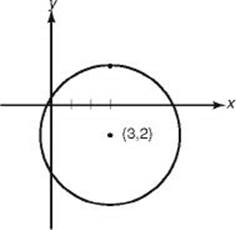
36. (E) The domain of f is the set of all real numbers for which f (x) is defined. The only potential problem is that the denominator could be 0. However, for any real number x, x 2 + 9 is positive. The denominator of f (x) is never equal to 0, and the domain of f is the set of all real numbers.
![]() **If you graph
**If you graph ![]() on a graphing calculator, you can see that all four of the answer choices (–4, –3, 3, and 4) are in the domain.
on a graphing calculator, you can see that all four of the answer choices (–4, –3, 3, and 4) are in the domain.
37. (A)

![]() **Use TACTIC 3. Pick any number for x and use your calculator to evaluate the given expression and each of the answer choices.
**Use TACTIC 3. Pick any number for x and use your calculator to evaluate the given expression and each of the answer choices.
38. (D) When 21, 22, and 23 are divided by 4, the remainders are 1, 2, and 3, respectively.
Therefore, by KEY FACT P2, i 21 = i, i 22 = i 2 = –1, and i 23 = i 3 = –i.
So i 21 is not a real number (I is false);
i 21 + i 22 = i + (–1), which is also not a real number (II is false); i 21 + i 22 + i 23 = i + –1 + (–i) = –1, which is a real number (III is true).
Only III is true.
39. (D) By KEY FACT H11, the area of ![]() RST is
RST is ![]() Since the area of the shaded region is 3 times as great, its area is
Since the area of the shaded region is 3 times as great, its area is ![]() and the total area of the square is
and the total area of the square is ![]() Finally, the length of side AB is
Finally, the length of side AB is ![]()
40. (D) If s is the side of the cube, then by KEY FACT H7, the length of EG, a diagonal of the square base, is s ![]() . So in right
. So in right ![]() AEG, by the Pythagorean theorem, we have:
AEG, by the Pythagorean theorem, we have:
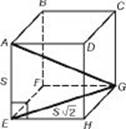

So by KEY FACT K1, the volume of the cube is:
![]()
41. (E) If r + si is a root of any quadratic equation with real coefficients, then r – si is also a root (I is true). Since (r + si ) + (r – si) = 2r, the sum of the roots is 2r. However, by KEY FACT E3, the sum of the roots of a quadratic equation is . ![]() (II is true). Since (r + si )(r – si ) = r 2 – s 2i 2 = r 2 – (s 2)(–1) = r 2 + s 2, the product of the roots is r 2 + s 2. However, by KEY FACT E3, the product of the roots of a quadratic equation is
(II is true). Since (r + si )(r – si ) = r 2 – s 2i 2 = r 2 – (s 2)(–1) = r 2 + s 2, the product of the roots is r 2 + s 2. However, by KEY FACT E3, the product of the roots of a quadratic equation is ![]() (III is true). I, II, and III are true.
(III is true). I, II, and III are true.
42. (A) Use TACTIC 4: draw and label a diagram.
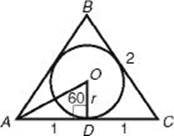
Then ![]() AOD is a 30-60-90 right triangle whose shorter leg is r, the radius of the circle, and whose longer leg, AD, is 1. But by KEY FACT H8, AD =
AOD is a 30-60-90 right triangle whose shorter leg is r, the radius of the circle, and whose longer leg, AD, is 1. But by KEY FACT H8, AD = ![]()

43. (E) y = f (g (x)) = f (2x – 5) = 7(2x – 5) + 3 = 14x – 35 + 3 = 14x – 32
y = g(f (x)) = g(7x + 3) = 2(7x + 3) – 5 = 14x + 6 – 5 = 14x + 1
By KEY FACT L8, the slope of each line is equal to 14. So by KEY FACT L7, the lines are parallel and, therefore, not perpendicular. (I is true and II is false).
y = f (g(x)) – g(f (x)) = (14x – 32) – (14x + 1) = –33
By KEY FACT L8, y = –33 is the equation of a horizontal line (III is true). Only I and III are true.
44. (B) By KEY FACT I9, the formula for the area of a parallelogram is A = bh. Use side ![]() as the base and draw in height
as the base and draw in height ![]() .
.
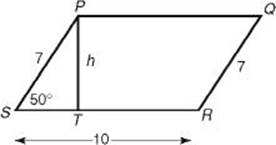
![]() Then by KEY FACT M1, sin
Then by KEY FACT M1, sin ![]() Finally:
Finally:
![]()
45. (D) By KEY FACT R4, a conditional statement (p ![]() q) is equivalent to its contrapositive (~p
q) is equivalent to its contrapositive (~p![]() ~q). Choice D is the contrapositive of the given statement. Note that whether or not the original statement is true is irrelevant. In this case it isn’t and, therefore, neither is its contrapositive.
~q). Choice D is the contrapositive of the given statement. Note that whether or not the original statement is true is irrelevant. In this case it isn’t and, therefore, neither is its contrapositive.
46. (E) By KEY FACT N6:
![]()
To find h–1(x), use KEY FACT N8. Write y = 28x + 23, switch x and y, and solve for y :
![]()
47. (B) Since each side of square BCDE is 2, hypotenuse ![]() of isosceles right
of isosceles right ![]() ABC is 2, and by KEY FACT H7,
ABC is 2, and by KEY FACT H7, ![]()
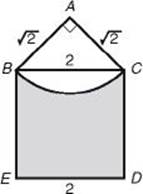
Since ![]() is a radius of the circle whose center is A and that passes through B and C, the area of the circle is
is a radius of the circle whose center is A and that passes through B and C, the area of the circle is ![]() m∠A = 90° sector ABC is
m∠A = 90° sector ABC is ![]() of the circle. So its area is
of the circle. So its area is ![]() The area of square ABCD is 22 = 4 and the area of
The area of square ABCD is 22 = 4 and the area of ![]() So the total area of the original figure is 4 + 1 = 5, and the area of the shaded region is
So the total area of the original figure is 4 + 1 = 5, and the area of the shaded region is ![]()
**Use TACTICS 5 and 8: trust the diagram and eliminate absurd choices. Since the area of square BCDE is 4, the area of the shaded region must be slightly less than 4. Immediately eliminate choice A, which is greater than 4, and choice C, which is negative. Choices B, D, and E are all positive numbers less than 4, but choices D and E are much too small. The answer must be B.
48. (E) If x pounds of peanuts are added to the existing mixture, the result will be a mixture whose total weight will be (70 + x) pounds, of which (20 + x) pounds will be peanuts. Then, by expressing 60% as ![]() we have
we have
![]()
![]() **Use TACTIC 2: backsolve. If 42 pounds of peanuts are added, peanuts will be
**Use TACTIC 2: backsolve. If 42 pounds of peanuts are added, peanuts will be ![]() of the mixture. Since that is not enough, eliminate choice C and choices A and B, which are even smaller. Test D or E.
of the mixture. Since that is not enough, eliminate choice C and choices A and B, which are even smaller. Test D or E.
49. (B) By KEY FACTS K8 and K6, the volume of a sphere is ![]() and the volume of a right circular cone is
and the volume of a right circular cone is ![]() (Remember that both of these formulas are given to you on the first page of the test.) Then:
(Remember that both of these formulas are given to you on the first page of the test.) Then:
![]()
**Use TACTIC 3. Plug in a number for the radius, say r = 1. Then the volume of the sphere is ![]() and the volume of the cone is
and the volume of the cone is ![]()
50. (D) Write out enough terms of the sequence until you see a pattern: 4, 5, 9, 14, 23, 37, 60, 97, 157, . . . The sequence of odds and evens repeats indefinitely in groups of three: ![]() , , . . . Since each group contains one even and two odds, the first 333 groups of 3 contain 999 terms—333 of which are even and 666 of which are odd. The 1,000th term is the first term of the next group and is even. So in all, there are 334 even terms and 666 odd terms.
, , . . . Since each group contains one even and two odds, the first 333 groups of 3 contain 999 terms—333 of which are even and 666 of which are odd. The 1,000th term is the first term of the next group and is even. So in all, there are 334 even terms and 666 odd terms.